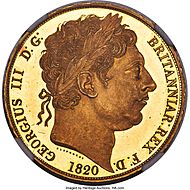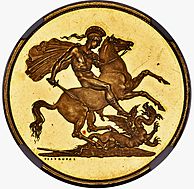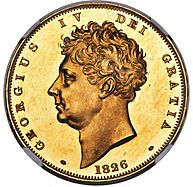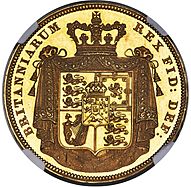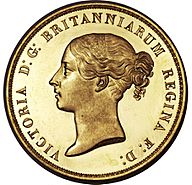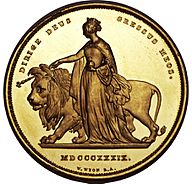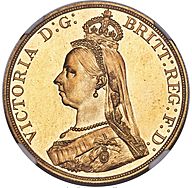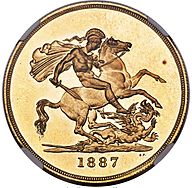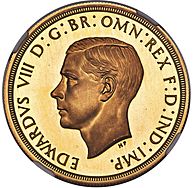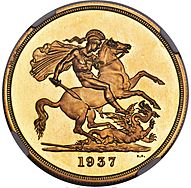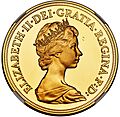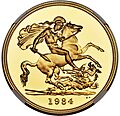Five pounds (British gold coin) facts for kids
| United Kingdom | |
| Value | £5 |
|---|---|
| Mass | 39.94 g |
| Diameter | 36.02 mm |
| Edge | Varies |
| Composition | .917 gold (22 carat) |
| Gold | 1.1771 troy oz |
| Years of minting | 1820, 1826, 1829, 1839, 1887, 1893, 1902, 1911, 1937, 1953, 1957, 1980–1982, 1984–2023 |
| Mint marks | S (1887 and 1902 only). Found on exergue between design and date. |
| Obverse | |
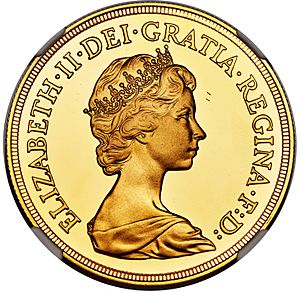 |
|
| Design | Reigning monarch (Elizabeth II shown) |
| Reverse | |
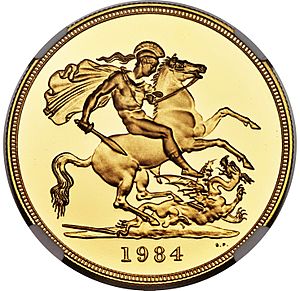 |
|
| Design | St George and the Dragon |
| Designer | Benedetto Pistrucci |
| Design date | 1817 (first appearance on five-pound coin in 1820). |
The five-pound British gold coin is also known as the quintuple sovereign. It has a value of five pounds. This special coin has been made off and on since 1820. However, it was only used as a regular coin in 1887, 1893, and 1902. For most of its history, the back of the coin has shown Benedetto Pistrucci's famous picture of St George and the Dragon. This design is also found on the sovereign, which is a one-pound gold coin.
The five-pound coin was one of the first gold coins planned after the Great Recoinage of 1816. This was a big change to Britain's money system. The coin was not made until 1820, and then only as a "pattern coin." A pattern coin is a test coin, not meant for general use. It was made again in small numbers in 1826, 1829, and 1839. The 1839 coin featured a very popular design called "Una and the Lion" by William Wyon. Even though the Royal Mint sold the Una coin for almost 50 years, only about 400 were ever made.
In 1887, the five-pound coin was made for people to use for the first time. This also happened in 1893 and 1902, but not many were actually used. Coins made in 1911 were only available in special collector sets. In 1887 and 1902, a few were made at the Sydney Mint in Australia. These coins have a small "S" mark. Coins made for Edward VIII are very rare and valuable. One sold in 2021 for over £1.6 million, which is the highest price ever paid for a British coin.
Since 1980, the Royal Mint has made the five-pound gold coin almost every year. They sell these coins to collectors and people who buy bullion (gold in bulk). While most coins feature Pistrucci's design, some special versions have been made. For example, in 2022, a memorial coin was issued after the death of Elizabeth II. It showed her son and new king, Charles III.
Contents
How the Five-Pound Coin Began
Before the five-pound gold coin, there was a coin called the five guinea. This coin was first made in 1668 and was worth 100 shillings, or five pounds. The value of a guinea changed over time, but it settled at 21 shillings in 1717. Some experts believe the five-pound coin made after 1816 was just a continuation of this older coin. The last five guinea coin was made in 1753.
After the Napoleonic Wars, the British Parliament decided to officially put Britain on the gold standard in 1816. This meant the value of the pound would be based on a certain amount of gold. Most people wanted a coin worth 20 shillings, not the guinea. The new gold coins were easier to use because their value was exactly one pound.
A special committee suggested making gold coins worth ten shillings, twenty shillings, two pounds, and five pounds. George, Prince Regent agreed to this on August 3, 1816. The 20-shilling coin was named a "sovereign," bringing back an old name. The sovereign and half sovereign were first made in 1817. However, the larger two-pound and five-pound coins were not made right away. Before this, people used bank notes for larger amounts of money. The St George and the dragon design was suggested for the sovereign by its creator, Benedetto Pistrucci. He based it on a carving he had made.
Early Five-Pound Coins
The first five-pound coin after the money reform was a pattern coin made in 1820. It showed George III (who ruled from 1760 to 1820). The front of the coin shows the king's face looking right. The words around it say "George III by the grace of God king of the Britains, defender of the faith" and the date. The back shows Pistrucci's George and dragon design without any words or date. This design first appeared on the sovereign in 1817. Pistrucci's name is at the bottom left of the design.
There's a story that work on the 1820 coin finished just before George III died. Pistrucci supposedly heard church bells announcing the king's death and rushed back to the Royal Mint. He then told them to strike some five-pound coins the next morning. While this is a "fascinating episode," later studies show the coin dies were finished after the king's death on January 29. About 25 of these coins were given to important people and museums. One sold in 2021 for about £635,000.
The five-pound coin appeared again during the reign of George IV (who ruled from 1820 to 1830). This was in 1826, as part of a special set of coins. One coin from 1829 is also known. The front of the 1826 coin shows the king's face looking left. The words say "George IV by the grace of God..." The back shows a crowned shield with the words "King of the Britains, defender of the faith." The 1826 coin has words on its edge that mean "An ornament and a safeguard; seventh year of the reign." The 1829 coin has a plain edge. No five-pound coins were made during the reign of William IV (who ruled from 1830 to 1837).
Queen Victoria's Five-Pound Coins
The next five-pound coin was made early in the reign of Queen Victoria (who ruled from 1837 to 1901). This coin is considered one of the most famous and beautiful British coins. It is known as the "Una and the Lion" coin and is very popular with collectors. Una and the Lion are characters from Edmund Spenser's 16th-century poem, The Faerie Queene. The front of the coin shows a young Queen Victoria looking left. The words say "Victoria by the grace of God queen of the Britains, defender of the faith." The back shows Victoria as Una, leading a lion. The words on the back mean "May the Lord direct my steps" or "The Lord directs my steps." The date 1839 is below the lion. The edge of the coin might have words meaning "an ornament and a safeguard; in the third year of the reign," or it might be plain. The Royal Mint sold these coins until 1886. About 400 were made. A coin in excellent condition sold in 2021 for US$1.44 million.
Pistrucci's George and dragon design returned to the five-pound coin in 1887. This was part of the "Jubilee coinage" to celebrate Queen Victoria's 50 years on the throne. The front of this new coin was designed by Joseph Boehm. The words on the coin say "Victoria by the grace of God queen of the Britains, defender of the faith." The word "Britanniarum" was shortened to "BRITT" with two "T"s. This was because a politician named Gladstone pointed out that Latin plural words should have a doubled consonant when shortened.
The 1887 five-pound coin was the first time this coin was available to the public at its actual value. Earlier coins were mostly test coins or special collector coins. Besides those sold at face value, special proof coins were made for the 1887 proof set. The five-pound and two-pound coins were not used much in daily life. People mostly kept them as souvenirs. Still, the 1887 issue made the five-pound coin the highest-value coin used in Britain. A few of the 1887 five-pound coins were made at the Sydney Mint and have an "S" mark on the back. These are extremely rare, with only two known in private collections. One sold in 2021 for US$660,000.
The Pistrucci design was used again in 1893. The front of the coin showed the queen's "Old Head" or "Veil Head" portrait. The words on the coin said "Victoria, by the grace of God queen of the Britains, defender of the faith, empress of India." The edge of the coin was milled (had ridges). Victoria had wanted her title as empress of India to be on the coins since 1888. This title was given to her by the Royal Titles Act 1876. So, "IND IMP," short for "empress of India," appeared on the 1893 coin. This coin was available both at its face value and in special proof sets.
Early 20th-Century Five-Pound Coins
After Queen Victoria died in January 1901, plans began for the coins of her son, Edward VII (who ruled from 1901 to 1910). A five-pound coin, with a front design by George William de Saulles, was made official on January 1, 1902. The Royal Mint decided to change as little as possible for King Edward's coins. So, the Pistrucci design stayed on the back of the gold coins. Five-pound coins were made both for general use and in special proof sets to celebrate the coronation of Edward VII. The words on the front said "Edward VII, by the grace of God king of all the Britains, defender of the faith, emperor of India." The word "OMN" (meaning "of all") was added after "BRITT." This was to recognize the help from the British Empire during the Boer War. These words last appeared on British coins in 1953. During Edward's reign, five-pound coins were only made in 1902. A small number of coins with an "S" mint mark were made in Sydney in 1902 and are very rare.
Five-pound coins dated 1911 were made for the special coronation proof sets for George V (who ruled from 1910 to 1936). However, for unknown reasons, no regular, non-proof coins were made. This was the only time five-pound coins were made during his reign. These coins featured a picture of King George by Bertram Mackennal. They also had Pistrucci's design on the back. The words on the coin were the same, just with King George's name.
After King George died in 1936, plans started for the coins of his son, Edward VIII (who ruled in 1936). The new king wanted his face to look left on the new coins. This would break a tradition of changing the direction of the king's face with each new ruler, a tradition that started in 1660. After many discussions, Edward got his way. Test coins with his left-facing face, designed by Thomas Humphrey Paget, were made. The Pistrucci design was used on the back. But the king gave up his throne in December 1936, ending these plans. Edward later asked for a set of these test coins, but his brother and new king, George VI (who ruled from 1936 to 1952), refused. Edward's five-pound coin is extremely rare. Only two are known to be owned by private collectors. One sold in 2021 for US$2.28 million, a record for a British coin. The words on Edward's five-pound coin were the same as the previous reign, just with his name and the date. A similar change was made for George VI. His five-pound coin shows his left-facing face by Paget and the Pistrucci design on the back. This coin was only made in 1937, with a plain edge, as part of the coronation proof sets. None were made for general use, as gold coins had stopped being used in Britain 20 years earlier.
Elizabeth II and Charles III Coins
During the reign of Queen Elizabeth II (who ruled from 1952 to 2022), there was a change in how gold coins were issued. Usually, all four gold coin values (half sovereign, sovereign, double sovereign, and five-pound piece) were available to the public in the coronation year. A small number of gold £5 coins were made in 1953, the year of Elizabeth's coronation. This was to keep the series going. They were made again in 1957. These coins had a picture of Elizabeth by Mary Gillick on the front and the Pistrucci design on the back. But neither of these coins were released to the public. The 1953 coins had words on the front saying "Elizabeth II by the grace of God queen of all the Britains, defender of the faith." But for 1957, the words "of all the Britains" were removed. This change recognized the growing British Commonwealth, which by then included some republics. The new wording continued on Elizabeth's coins, with small changes in how words were shortened.
No more £5 gold coins were made until 1980, nine years after Britain switched to decimal money. The Royal Mint realized that people wanted sovereign coins. So, they started selling them to collectors for much more than their face value or gold value. Starting in 1980, five-pound gold coins were sold almost every year, except 1983. Sometimes they were part of a four-coin set with the half sovereign, sovereign, and double sovereign. Sometimes they were sold alone. The coins sold alone were in "uncirculated" condition (meaning they had not been used). They had a small "U" to the left of the date. Coins made until 1984 used a portrait of Elizabeth by Arnold Machin. Later ones until 1997 used a portrait by Raphael Maklouf. The only exception was the 1989 coin, which had special designs by Bernard Sindall to celebrate 500 years of the sovereign coin.
From 1998, a new portrait of Elizabeth by Ian Rank-Broadley was used on the five-pound coin. This portrait was used until 2015. The Pistrucci design stayed on the back, except in 2002, 2005, and 2012. In these years, special designs were used instead. The special designs on the back were for Elizabeth II's Golden Jubilee in 2002 (by Timothy Noad, showing a crowned shield in a wreath). In 2005, a more modern version of George and the dragon was used, also by Noad. In 2012, for Elizabeth II's Diamond Jubilee, another modern George and dragon design by Paul Day was used. Starting in 2009, the Pistrucci design for the five-pound coin was updated. It looked more like the original 1820 test coin, with the designer's full last name to the left of the date and a wider rim on the coin.
Some coins from 2015 started using a portrait of Elizabeth by Jody Clark. In 2016, some coins had a different portrait of the queen by James Butler. In 2017, a version with the original 1817 sovereign design was made. This was to celebrate the 200th anniversary of the modern sovereign.
In 2022, the Royal Mint made five-pound coins with a back design by Noad. It showed a version of the Royal Arms. This design was used for the sovereign coins to mark Queen Elizabeth II's Platinum Jubilee. Later in 2022, after Queen Elizabeth II died, the Royal Mint issued special memorial coins. This included the five-pound coin. It featured a version of the Royal Arms by Clark on the back. On the front, it had the first coin portrait of Elizabeth's son and new king, Charles III (who began ruling in 2022), by Martin Jennings. Besides a left-facing picture of Charles, the front had words saying "Charles III by the grace of God king, defender of the faith." In 2023, a five-pound coin was made to celebrate the coronation of Charles III. The front showed a crowned portrait of the king by Jennings, and the back had the Pistrucci George and dragon design.
Images for kids


